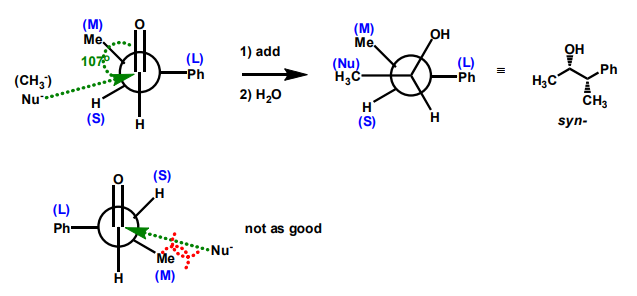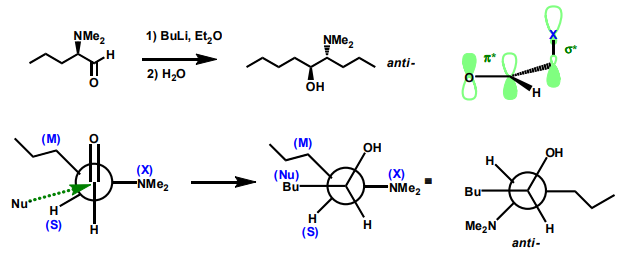- 1. Getting Started
-
2.
First Semester Topics
-
General Chemistry Review
- Introduction
- Electron Configurations of Atoms
- QM Description of Orbitals
- Practice Time - Electron Configurations
- Hybridization
- Strategy to Determine Hybridization
- Practice Time! - Hybridization
- Formal Charge
- Practice Time - Formal Charge
- Acids-bases
- Practice Time - Acids and Bases
- Hydrogen Bonding is a Verb!
- Progress Pulse
-
Structure and Bonding
- Chemical Intuition
- Difficulty-in-organic-chemistry
- Atomic Orbitals
- Electron Configurations of Atoms
- Electron Configurations Tutorial
- Practice Time - Structure and Bonding 1
- Lewis Structures
- Drawing Lewis Structures
- Valence Bond Theory
- Valence Bond Theory Tutorial
- Hybridization
- Polar Covalent Bonds
- Formal Charge
- Practice Time - Structure and Bonding 2
- Curved Arrow Notation
- Resonance
- Electrons behave like waves
- MO Theory Intro
- Structural Representations
- Progress Pulse
-
Acids/Base and Reactions
- Reactions
- Reaction Arrows: What do they mean?
- Thermodynamics of Reactions
- Acids Intro
- Practice Time! Generating a conjugate base.
- Lewis Acids and Bases
- pKa Scale
- Practice Time! pKa's
- Predicting Acid-Base Reactions from pKa
- Structure and Acidity
- Structure and Acidity II
- Practice Time! Structure and Acidity
- Curved Arrows and Reactions
- Nucleophiles
- Electrophiles
- Practice Time! Identifying Nucleophiles and Electrophiles
- Mechanisms and Arrow Pushing
- Practice Time! Mechanisms and Reactions
- Energy Diagrams and Reactions
- Practice Time! - Energy Diagrams
- Progress Pulse
- Introduction to Retrosynthesis
-
Alkanes and Cycloalkanes
- Introduction to Hydrocarbons and Alkanes
- Occurrence
- Functional Groups
- Practice Time! Functional Groups.
- Structure of Alkanes - Structure of Methane
- Structure of Alkanes - Structure of Ethane
- Naming Alkanes
- Practice Time! Naming Alkanes
- Relative Stability of Acyclic Alkanes
- Physical Properties of Alkanes
- Ranking Boiling Point and Solubility of Compounds
- Conformations of Acyclic Alkanes
- Practice Time! Conformations of acyclic alkanes.
- Conformations of Cyclic Alkanes
- Naming Bicyclic Compounds
- Stability of Cycloalkane (Combustion Analysis)
- Degree of Unsaturation
-
Stereochemistry
- Enalapril in ACE
- Constitutional and Stereoisomers
- Chirality or Handedness
- Drawing a Molecules Mirror Image
- Exploring Mirror Image Structures
- Enantiomers
- Drawing Enantiomers
- Practice Time! Drawing Enantiomers
- Identifying Chiral Centers
- Practice Time! Identifying Chiral Molecules
- CIP (Cahn-Ingold-Prelog) Priorities
- Determining R/S Configuration
- Diastereomers
- Meso Compounds
- Fischer Projections
- Fischer Projections: Carbohydrates
- Measuring Chiral Purity
- Practice Time! - Determining Chiral Purity and ee
- Chirality and Drugs
- Chiral Synthesis
- Prochirality
- Converting Fischer Projections to Zig-zag Structures
- Practice Time! - Assigning R/S Configurations
-
Alkenes and Addition Reactions
- The Structure of Alkenes
- Alkene Structure - Ethene
- Naming Alkenes
- Health Insight - BVO (Brominated Vegetable Oil)
- E/Z and CIP
- Stability of Alkenes
- H-X Addition to Alkenes: Hydrohalogenation
- Practice Time - Hydrohalogenation
- X2 Addition to Alkenes: Halogenation
- HOX addition: Halohydrins
- Practice Time - Halogenation
- Hydroboration/Oxidation of Alkenes: Hydration
- Practice Time - Hydroboration-Oxidation
- Oxymercuration-Reduction: Hydration
- Practice Time - Oxymercuration/Reduction
- Oxidation and Reduction in Organic Chemistry
- Calculating Oxidation States of Carbon
- Identifying oxidation and reduction reactions
- Practice Time - Oxidation and Reduction in Organic
- Oxidation
- Reduction
- Capsaicin
- Alkynes
- Alcohols and Alkyl Halides
- Substitutions (SN1/SN2) and Eliminations (E1/E2)
- Dienes, Allylic and Benzylic systems
-
General Chemistry Review
-
3.
Second Semester Topics
- Arenes and Aromaticity
-
Reactions of Arenes
- Electrophilic Aromatic Substitution
- EAS-Halogenation
- EAS-Nitration
- Practice Time - Synthesis of Aniline
- EAS-Alkylation
- Practice Time - Friedel Crafts Alkylation
- EAS-Acylation
- Practice Time - Synthesis of Alkyl Arenes
- EAS-Sulfonation
- Practice Time - EAS
- Effect on Rate and Orientation
- Donation and Withdrawal of Electrons
- Regiochemistry in EAS
- Practice Time - Directing Group Effects
- Steric Considerations
- Synthesizing Poly-substituted Benzene's
- NAS - Addition/Elimination
- NAS - Elimination/Addition - Benzyne
- Alcohols and Phenols
-
Ethers and Epoxides
- Intro and Occurrence
- Crown Ethers and Cryptands
- Preparation of Ethers
- Reactions of Ethers
- Practice Time - Ethers
- Preparation of Epoxides
- Reactions of Epoxides - Acidic Ring Opening
- Practice Time - Acidic Ring Opening
- Reactions of Epoxides - Nucleophilic Ring Opening
- Practice Time - Nucleophilic Ring opening
- Application - Epoxidation in Reboxetine Synthesis
- Application - Nucleophilic Epoxide Ring Opening in Crixivan Synthesis
- Naming Ethers and Epoxides
-
Aldehydes and Ketones
- Naming Aldehydes and Ketones
- Practice Time - Naming Aldehydes/Ketones
- Nucleophilic addition
- Addition of Water - Gem Diols
- Practice Time - Hydration of Ketones and Aldehydes
- Addition of Alcohols - Hemiacetals and Acetals
- Acetal Protecting Groups
- Hemiacetals in Carbohydrates
- Practice Time - Hemiacetals and Acetals
- Addition of Amines - Imines
- Addition of Amines - Enamines
- Practice Time - Imines and Enamines
- Application - Imatinab Enamine Synthesis
- Addition of CN - Cyanohydrins
- Practice Time - Cyanohydrins
- Application - Isentress Synthesis
- Addition of Ylides - Wittig Reaction
- Practice Time - Wittig Olefination
- Carboxylic Acids and Derivatives
- Enols and Enolates
- Condensation Reactions
- 4. Spectroscopy - NMR, IR and UV
-
5.
Special Topics
-
Acyl Transfer Reagents and Catalysts
-
Asymmetric Synthesis
- General Principles
- Substitutions
-
1,2 and 1,4 Additions
- Aldol and Micheal Additions
- Chiral Pool Synthesis
- Reductions and Hydroborations
- Crystallization-Induced Asymmetric Transformation (CIAT)
- Oxidations
- Cycloadditions
- Dynamic Kinetic Resolution (DKR)
- Curtin-Hammett Principle
- Organocatalysis
- Double Stereodifferentiation
- Felkin Ahn JSMol
- Felkin Ahn JSMol 2
- Felkin-Anh Model
- Kinetic Resolution
- The Burgi-Dunitz Trajectory
- Zimmerman-Traxler Model
- Zimmerman-Traxler TS1
- Complex Induced Proximity Effect (CIPE)
- Introduction to Drug Development
- Kinetic Isotope Effects
- Organometallic Chemistry
- Pericyclic Reactions
-
Acyl Transfer Reagents and Catalysts
-
6.
General Chemistry
- General Chemistry Lab
- Calculator Tips for Chemistry
- Significant Figures
- Practice Time! Significant Figures
- Spreadsheets - Getting Started
- Spreadsheets - Charts and Trend lines
- Standard Deviation
- Standard Deviation Calculations
- Factor Labels
- Practice Time! - Factor Labels
- Limiting Reagent Problem
- Percent Composition
- Molar Mass Calculation
- Average Atomic Mass
- Empirical Formula
- Practice time! Empirical and Molecular Formulae
- Initial Rate Analysis
- Practice Time! Initial Rate Analysis
- Solving Equilibrium Problems with ICE
- Practice Time! Equilibrium ICE Tables
- Le Chatelier's
- Practice Time! Le Chatelier's Principle
- 7. Organic Chemistry Lab
-
8.
Question Of The Day
- 9. Tools and Reference
-
10.
Tutorials
- Using OpenOChem's 2D Editor
- Reaction Mechanisms (introduction)
- Factor Labels
- Acetylides and Synthesis
- Drawing Cyclohexane Chair Structures
- Drawing Lewis Structures
- Aromaticity Tutorial
- Common Named Aromatics (Crossword Puzzle)
- Functional Groups (Flashcards)
- Alkyl and Alkenyl Groups
- Valence Bond Theory
Clear History
Felkin-Anh Model
- Overview: Predicts the stereochemical outcome of nucleophilic addition to a carbonyl compound. The model suggests that the nucleophile attacks at an angle (Bürgi-Dunitz trajectory), favoring the least sterically hindered face of the carbonyl.
- Key Features:
- Large substituents orient anti to the carbonyl group (minimizing steric hindrance).
- Explains the formation of major diastereomers in reactions like aldol or Grignard additions.
- Variants: The Cram's Rule is a precursor but less nuanced than Felkin-Anh.
The largest group (determined using the A value table for steric bulk) prefers a conformation where it is positioned perpendicular to the carbonyl C=O bond. This results in two closely competing low-energy conformations, where the medium and smallest groups alternate in their proximity to the carbonyl oxygen.

The nucleophiles does not attack at a 90° angle to the C=O bond but at an angle closer to the tetrahedral bond angle (approximately 107°). This trajectory of approach is known as the Bürgi-Dunitz trajectory. Predictably, the nucleophile favors an approach that avoids the steric hindrance of the largest group.
This leaves two possible attack pathways: one where the nucleophile approaches closest to the smallest group, and another where it approaches nearest to the medium group. The nucleophile preferentially attacks closer to the smallest group, leading to the formation of a specific diastereomer as the major product.

In most cases (though not universally), the largest group becomes part of the main chain in the product, while the incoming nucleophile forms the other end of the main chain. Under these conditions, the major diastereomer is typically the syn-diastereomer.
If there is an electronegative atom or group at the α-position to the carbonyl, the Felkin-Anh model undergoes a slight adjustment. For this discussion, electronegative groups (X) are limited to halogens, OR, NR₂, or SR groups. In such cases, the electronegative group effectively becomes the "large" group in the Felkin-Anh model.
The energy of the C-X σ* antibonding orbital is relatively low, allowing it to overlap with the π* orbital of the carbonyl. This interaction creates a new, lower-energy LUMO (lowest unoccupied molecular orbital), making this specific conformational arrangement more reactive than others.
With this shift, the Felkin-Anh addition proceeds similarly to before. However, in most cases (though not universally), the "medium" group ends up incorporated into the product's main chain. As a result, the anti-diastereomer is typically favored in these reactions.
